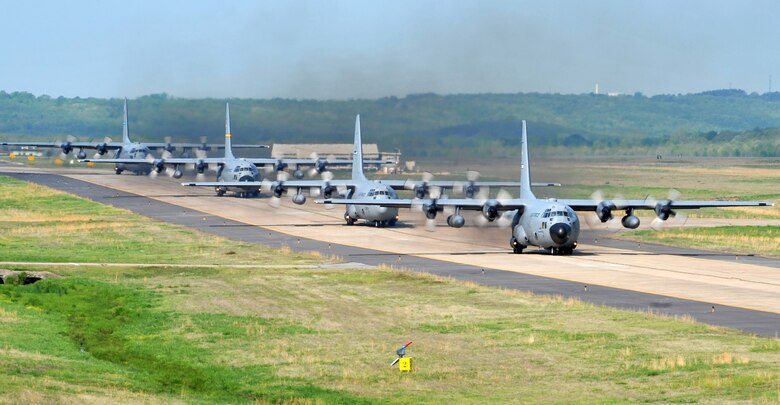The Air Force Civil Engineer Center is leading a $180 million project to replace the 64-year-old runway at Little Rock Air Force Base, Arkansas.
AFCEC's Facility Engineering Directorate is teaming with the Air Force Installation and Mission Support Center's Detachment 9, 772nd Enterprise Sourcing Squadron and 19th Civil Engineering Squadron to replace the 12,000-foot-long primary runway, eliminate airfield obstructions and modify the lighting and navigation aid systems.
"The Air Force depends on the technical expertise of the professionals from AFCEC and 772nd ESS to deliver quality runway and infrastructure solutions for mission commanders" said Col. Scott Matthews, director of AFCEC Facility Engineering Directorate. "This runway is 64 years old and we have incorporated modern design and construction techniques to ensure the longest lifespan at the overall lowest life cycle cost."
AFCEC and Air Force Installation Contracting Center, primary subordinate units of AFIMSC, will oversee the project. California-based engineering firm Contrack ECC, LLC, which was awarded the contract May 29, will execute the runway replacement. The project is expected to be completed in three phases over 40 months.
Replacing the runway will ensure Little Rock AFB's status as the C-130 Center of Excellence, said Col. John Schutte, 19th Airlift Wing installation commander.
"This vital airfield construction project will posture Little Rock Air Force Base to train, receive and project combat airlift forces for generations to come," Schutte said. "The upgrades and modifications being made to our 12,000-foot runway will improve both mission capability and safety for the largest fleet of C-130s in the world."
While AFCEC and the 19th CES have worked together in the past, a project of this magnitude where AFCEC serves as the design and construction agent, is a new experience for Mike Boyle, 19th CES Engineering flight chief.
"This partnership has been a learning experience for all parties, and it has resulted in a true team effort to replace the runway," Boyle said. "We all have the same goal of achieving a high quality construction project and efficient completion of the project."
Little Rock AFB provides combat airlift worldwide and trains pilots and aircrew for all Department of Defense branches. In order to provide rapid air mobility, the base needs a reliable, safe runway that meets the dimensions and weight-bearing capacity for their aircraft.
The decades-old runway was suffering from a substantial number of joint cracks and cracked slabs caused by seasonal weather fluctuations and heavy wheel loads from aircraft.
"We have used modern design and construction techniques to ensure the lifespan of the new runway will easily surpass the current runway," Matthews said.
Once completed, the runway will also accommodate other aircraft in the Air Mobility Command fleet such as the C-5 Galaxy, KC-10 Extender, C-17 Globemaster III and KC-135 Stratotanker.
"At the end of the day, it's a full restoration for the training wing and the operational wing to conduct their missions," said Don Johnston, AFCEC project manager.
The runway replacement improves safety for pilots by ensuring they have a full field of vision entering and exiting the active airfield.
"The current runway has a bow, almost a hill, in the middle," Johnston said. "You can stand at the west end of the runway, and if there's a C-130 on the east end, you can't see it. With the current airfield requirements, you must have a clear line of sight down the entire length of the runway."
The first of three project phases begins in October and includes replacing the landing zone and the center taxiway. Phases 2 and 3 will focus on construction on the East and West portions of the runway and installing new lighting and navigational aid systems.
Using concrete for the runways will save money, Johnston said.
"There were other options, such as building with concrete touchdowns and a center portion," Johnston said. "The option we went with, the full concrete, was the lowest life cycle cost. It's more expensive up front, but the full concrete runway has the longest life cycle span of anything else we looked at. Instead of replacing the runway in 30 to 40 years, we're going to probably replace it in 60 to 70 years."

C-130's taxi at Little Rock Air Force Base, Ark. during an operational exercise. The 19th Civil Engineer Squadron at Little Rock AFB, has been completing interim runway repairs to keep the runway operational and the mission going. The Air Force Civil Engineer Center is leading a $180 million project to replace the 64-year-old runway at the base. (U.S. Air Force photo by Airman 1st Class Rusty Frank)

Contractors prepare a concrete slab for the new runway at Little Rock Air Force Base, Ark., in 2014, the interim part of the runway replacement. On May 29, 2020, the Air Force Civil Engineer Center and the Air Force Installation Contracting Center awarded the contract to complete the runway replacement for the 12,000-foot-long runway at Little Rock AFB. (U.S. Air Force courtesy photo)






